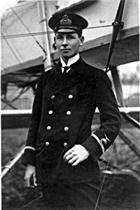On this day 7 June 1915
Flt S/Lt Rex Warnford of No.1 Naval Aeroplane Squadron, flying Morane MS3 Type L Parasol, destroys Zeppelin LZ37 near Ghent. He is awarded the first FAA Victoria Cross and the Légion d'honneur by the French.
No. 1 Naval Aeroplane Squadron, 8th June 1915, official report by Flight Sub-Lieutenant Reginald Warneford to Wing Commander AM Longmore (Air 1/672)
I left Furnes at 1:00 am on 7th June 1915 on Morane No. 3253 under orders to look for Zeppelins and attack the Berchem St Agathe Airship Shed with six 20 lb bombs. On arriving at Dixmude at 1:15 am, I observed a Zeppelin apparently over Ostend and proceeded in chase of the same. I arrived at close quarters a few miles past Bruges at 1:50 am and the airship opened heavy maxim fire, so I retreated to gain height and the airship turned and followed me.
At 2:15 am it stopped firing and 2:25 am I came behind, but well above the Zeppelin; height then 11,000 feet, and switched off my engine to descend on top of him. When close above him at 7,000 feet altitude I dropped my bombs, and, whilst releasing the last, there was an explosion which lifted my machine and turned it over. The aeroplane was out of control for a short period, went into a nose dive, but control was regained. I then saw the Zeppelin was on the ground in flames.
The joint on my petrol pipe and pump from the back tank was broken and at about 2:40 am I was forced to land in enemy territory to repair my pump. I made preparations to set the machine on fire, but was not observed, so was able to effect a repair of the aircraft and after considerable difficulty in starting my engine single handed, was able to take off and head in a South Westerly direction.
I tried several times to find my whereabouts but was unable to do so, so I eventually landed and discovered I was at Cap Gris Nez, where I was given petrol by French soldiers. When the weather cleared I was able to proceed and arrived back at my Aerodrome about 10:30 am.
As far as could be seen the colour of the Airship was green on top and yellow below and there was no machine gun or platform on top.
London Gazette, 11 June 1915
For most conspicuous bravery on the 7th June 1915, when he attacked and, single-handed, completely destroyed a Zeppelin in mid-air. This brilliant achievement was accomplished after chasing the Zeppelin from the coast of Flanders to Ghent, where he succeeded in dropping his bombs on to it from a height of only one or two hundred feet. One of these bombs caused a terrific explosion which set the Zeppelin on fire from end to end, but at the same time overturned his aeroplane and stopped the engine.
In spite of this he succeeded in landing safely in hostile country, and after 15 minutes started his engine and returned to his base without damage.
Warneford's death
Ten days later, on 17 June 1915, Warneford received the award of Légion d'honneur from the French Army Commander in Chief, General Joffre. After a celebratory lunch, Warneford travelled to the aerodrome at Buc in order to ferry an aircraft for delivery to the RNAS at Veurne. Having made one short test flight, he then flew a second flight, carrying an American journalist, Henry Beach Newman, as passenger. During a climb to 200 feet, the righthand wings collapsed leading to a catastrophic failure of the airframe. Accounts suggest that neither occupant was harnessed and were both thrown out of the aircraft, suffering fatal injuries. In the case of Newman, death was instantaneous. Warneford died of his injuries on the way to hospital. He was buried at Brompton Cemetery, London on Tuesday 22 June 1915 in a ceremony attended by thousands of mourners.
Rex Warneford's Victoria Cross is displayed at the Fleet Air Arm Museum.

